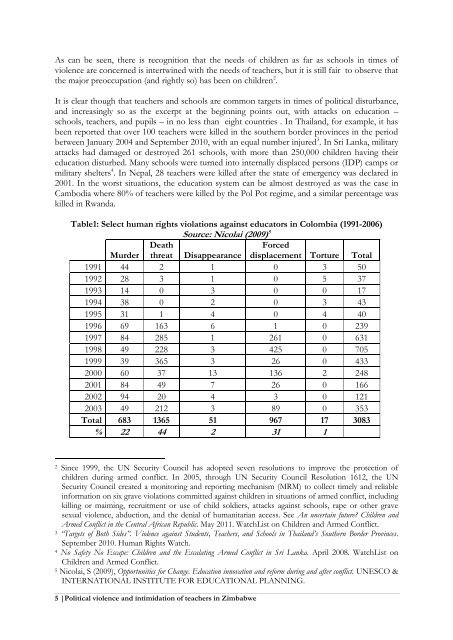Political violence and intimidation against Teachers in Zimbabwe
Political violence and intimidation against Teachers in Zimbabwe
Political violence and intimidation against Teachers in Zimbabwe
Create successful ePaper yourself
Turn your PDF publications into a flip-book with our unique Google optimized e-Paper software.
As can be seen, there is recognition that the needs of children as far as schools <strong>in</strong> times of<br />
<strong>violence</strong> are concerned is <strong>in</strong>tertw<strong>in</strong>ed with the needs of teachers, but it is still fair to observe that<br />
the major preoccupation (<strong>and</strong> rightly so) has been on children 2 .<br />
It is clear though that teachers <strong>and</strong> schools are common targets <strong>in</strong> times of political disturbance,<br />
<strong>and</strong> <strong>in</strong>creas<strong>in</strong>gly so as the excerpt at the beg<strong>in</strong>n<strong>in</strong>g po<strong>in</strong>ts out, with attacks on education –<br />
schools, teachers, <strong>and</strong> pupils – <strong>in</strong> no less than eight countries . In Thail<strong>and</strong>, for example, it has<br />
been reported that over 100 teachers were killed <strong>in</strong> the southern border prov<strong>in</strong>ces <strong>in</strong> the period<br />
between January 2004 <strong>and</strong> September 2010, with an equal number <strong>in</strong>jured 3 . In Sri Lanka, military<br />
attacks had damaged or destroyed 261 schools, with more than 250,000 children hav<strong>in</strong>g their<br />
education disturbed. Many schools were turned <strong>in</strong>to <strong>in</strong>ternally displaced persons (IDP) camps or<br />
military shelters 4 . In Nepal, 28 teachers were killed after the state of emergency was declared <strong>in</strong><br />
2001. In the worst situations, the education system can be almost destroyed as was the case <strong>in</strong><br />
Cambodia where 80% of teachers were killed by the Pol Pot regime, <strong>and</strong> a similar percentage was<br />
killed <strong>in</strong> Rw<strong>and</strong>a.<br />
Table1: Select human rights violations <strong>aga<strong>in</strong>st</strong> educators <strong>in</strong> Colombia (1991-2006)<br />
Source: Nicolai (2009) 5<br />
Murder<br />
Death<br />
threat Disappearance<br />
Forced<br />
displacement Torture Total<br />
1991 44 2 1 0 3 50<br />
1992 28 3 1 0 5 37<br />
1993 14 0 3 0 0 17<br />
1994 38 0 2 0 3 43<br />
1995 31 1 4 0 4 40<br />
1996 69 163 6 1 0 239<br />
1997 84 285 1 261 0 631<br />
1998 49 228 3 425 0 705<br />
1999 39 365 3 26 0 433<br />
2000 60 37 13 136 2 248<br />
2001 84 49 7 26 0 166<br />
2002 94 20 4 3 0 121<br />
2003 49 212 3 89 0 353<br />
Total 683 1365 51 967 17 3083<br />
% 22 44 2 31 1<br />
2 S<strong>in</strong>ce 1999, the UN Security Council has adopted seven resolutions to improve the protection of<br />
children dur<strong>in</strong>g armed conflict. In 2005, through UN Security Council Resolution 1612, the UN<br />
Security Council created a monitor<strong>in</strong>g <strong>and</strong> report<strong>in</strong>g mechanism (MRM) to collect timely <strong>and</strong> reliable<br />
<strong>in</strong>formation on six grave violations committed <strong>aga<strong>in</strong>st</strong> children <strong>in</strong> situations of armed conflict, <strong>in</strong>clud<strong>in</strong>g<br />
kill<strong>in</strong>g or maim<strong>in</strong>g, recruitment or use of child soldiers, attacks <strong>aga<strong>in</strong>st</strong> schools, rape or other grave<br />
sexual <strong>violence</strong>, abduction, <strong>and</strong> the denial of humanitarian access. See An uncerta<strong>in</strong> future? Children <strong>and</strong><br />
Armed Conflict <strong>in</strong> the Central African Republic. May 2011. WatchList on Children <strong>and</strong> Armed Conflict.<br />
3 “Targets of Both Sides”. Violence <strong>aga<strong>in</strong>st</strong> Students, <strong>Teachers</strong>, <strong>and</strong> Schools <strong>in</strong> Thail<strong>and</strong>’s Southern Border Prov<strong>in</strong>ces.<br />
September 2010. Human Rights Watch.<br />
4 No Safety No Escape: Children <strong>and</strong> the Escalat<strong>in</strong>g Armed Conflict <strong>in</strong> Sri Lanka. April 2008. WatchList on<br />
Children <strong>and</strong> Armed Conflict.<br />
5 Nicolai, S (2009), Opportunities for Change. Education <strong>in</strong>novation <strong>and</strong> reform dur<strong>in</strong>g <strong>and</strong> after conflict. UNESCO &<br />
INTERNATIONAL INSTITUTE FOR EDUCATIONAL PLANNING.<br />
5 |<strong>Political</strong> <strong>violence</strong> <strong>and</strong> <strong><strong>in</strong>timidation</strong> of teachers <strong>in</strong> <strong>Zimbabwe</strong>

















